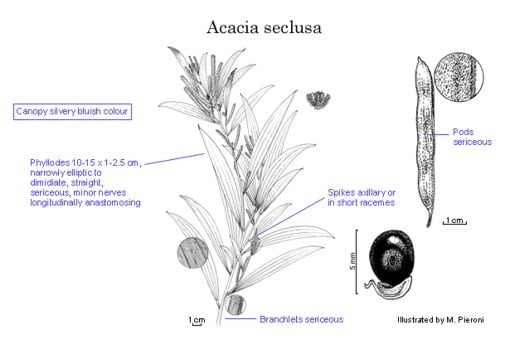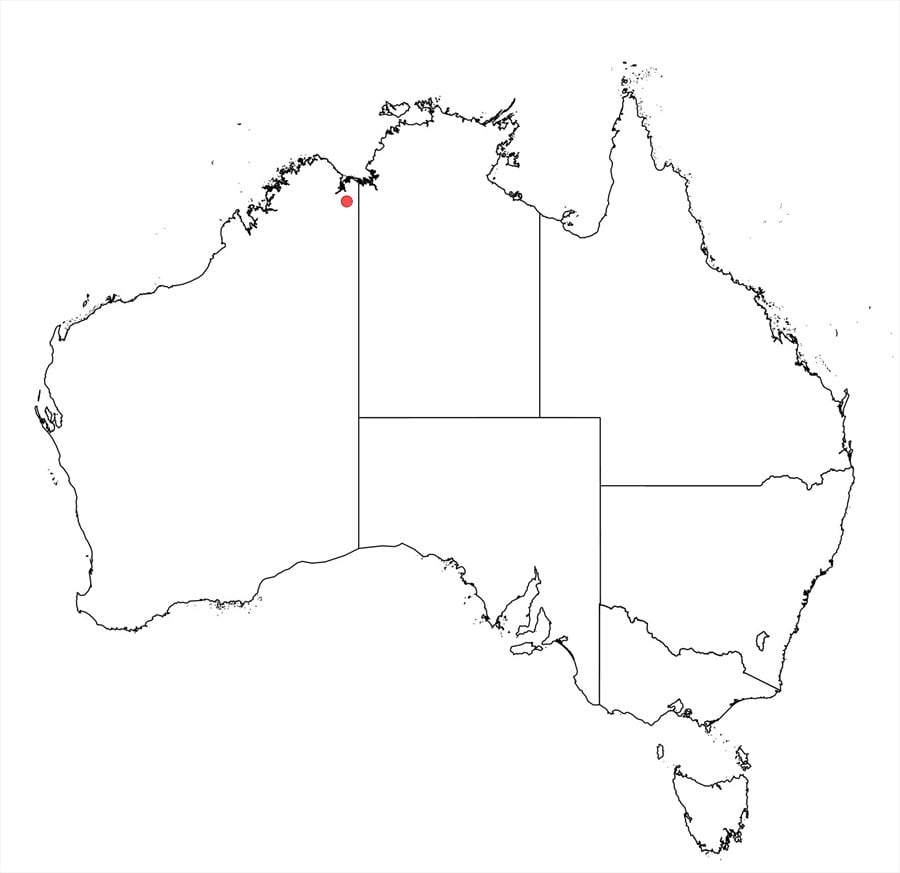Acacia seclusa M.W.McDonald
WATTLE
Acacias of Australia
Common Name
Saw Ranges Wattle
Family
Fabaceae
Distribution
Known only from Dillon Springs in the Saw Ra., Kimberley region, W.A.
Description
Tree or shrub 2–5 (–6) m tall, canopy often spreading. Bark hard, grey, shallowly rimose. New shoots sericeous, grey. Branchlets sericeous. Phyllodes narrowly elliptic to narrowly dimidiate, straight, 10–15 cm long, 1–2.5 cm wide, coriaceous, sericeous, grey-green; longitudinal nerves numerous and close together (6–8 per mm), moderately longitudinally anastomosing, with 3 main longitudinal nerves slightly more prominent than the others; pulvinus 5–7 mm long, sericeous. Inflorescences simple (1–3 per axil) or occasionally racemose, raceme axes 0.2–5 cm long and sericeous; peduncles 2–5 mm long, sericeous; spikes 2–5 cm long, flowers densely arranged, yellow to light golden; receptacles glabrous. Flowers 5-merous; calyx deeply dissected, densely pubescent; ovary sericeous. Pods narrowly oblong, sub-terete to slightly flattened, sometimes slightly constricted between the seeds, straight to slightly curved, 4–7 cm long, 6–8 mm wide, woody, sericeous, longitudinally wrinkled or grooved. Seeds oblique, elliptic to irregularly elliptic, 4 mm long, 3 mm wide, glossy, black; funicle/aril twice-folded, cream.
Phenology
Flowers in August.
Habitat
It grows near a spring in a steep rocky gully.
Specimens
W.A.: Dillen Springs, c. 50 km W of Kununurra, G.P.Guymer 526 (NE, NSW); Dillen Springs, Saw Ra., c. 40 km SW of Kununurra, M.W.McDonald 2133 (CANB, K, NSW, PERTH).
Notes
Acacia seclusa is a member of the ‘A. tumida group’ where it appears to be morphologically intermediate between A. tumida and A. retinervis. It is, however, distinguished in having straight, narrowly-elliptic to narrowly-dimidiate, sericeous phyllodes, simple or short racemose inflorescences and densely sericeous pods. It is also characterized by its strictly riparian habitat and in having a silvery, bluish appearance to its crown (due to the sericeous phyllodes). Acacia tumida var. tumida also occurs at Dillon Springs but is easily recognized, in addition to the characters already given, by its falcate, finely striate (not reticulate) phyllodes and its non-silvery crowns. A putative hybrid between these two species occurs at this site (M.W.McDonald 2134, PERTH).
FOA Reference
Data derived from Flora of Australia Volumes 11A (2001), 11B (2001) and 12 (1998), products of ABRS, ©Commonwealth of Australia
Author
B.R.Maslin, M.W.McDonald
This identification key and fact sheets are available as a mobile application:
URL: https://apps.lucidcentral.org/wattle/
© Copyright 2018. All rights reserved.







